Ethical Dilemma: Informed Consent and Patient Rights in Healthcare
VerifiedAdded on 2021/04/22
|9
|2598
|81
Case Study
AI Summary
This case study examines a scenario involving a nurse, Sheila, who faces an ethical dilemma regarding informed consent in an orthopedic unit. The patient, a German speaker, is not receiving adequate information due to a language barrier and the daughter's inadequate translation. The assignment analyzes the case using Potter and Perry's seven-step model for ethical decision-making, exploring the ethical dilemma, informed consent principles, personal values, and potential courses of action. The analysis highlights the importance of patient autonomy, comprehension, and the nurse's responsibility to advocate for the patient's rights, even when it conflicts with professional hierarchy. The paper also discusses relevant professional standards, including responsibility, accountability, competency-based practice, client-focused service, and ethical practice, as defined by CLPNBC. The conclusion emphasizes the need for nurses to prioritize patient well-being, ensure clear communication, and prevent future ethical breaches through proactive measures.

Running head: INFORMED CONSSESSION 1
Informed Consent
Student’s Name
Institutional Affiliation
Informed Consent
Student’s Name
Institutional Affiliation
Paraphrase This Document
Need a fresh take? Get an instant paraphrase of this document with our AI Paraphraser
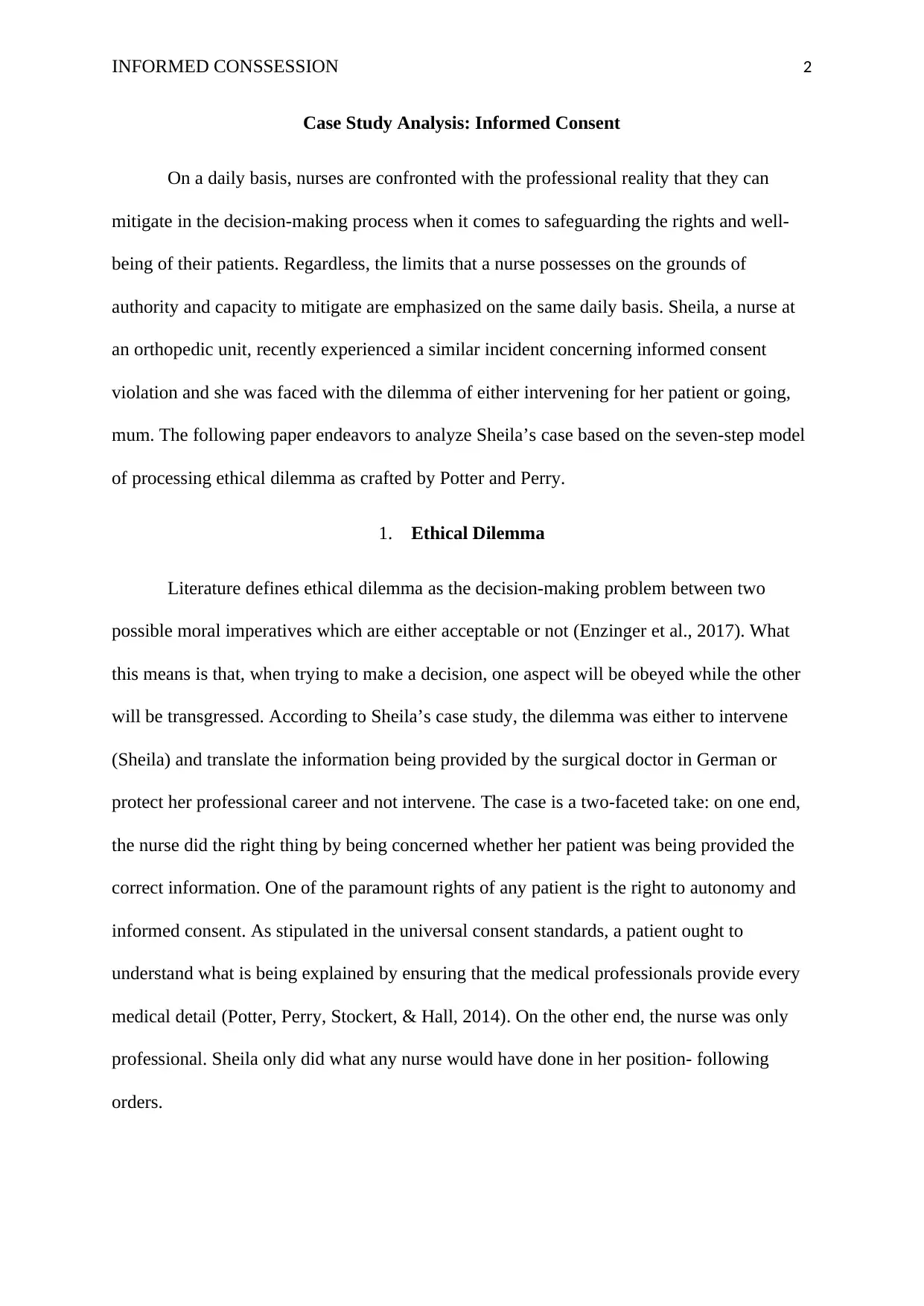
INFORMED CONSSESSION 2
Case Study Analysis: Informed Consent
On a daily basis, nurses are confronted with the professional reality that they can
mitigate in the decision-making process when it comes to safeguarding the rights and well-
being of their patients. Regardless, the limits that a nurse possesses on the grounds of
authority and capacity to mitigate are emphasized on the same daily basis. Sheila, a nurse at
an orthopedic unit, recently experienced a similar incident concerning informed consent
violation and she was faced with the dilemma of either intervening for her patient or going,
mum. The following paper endeavors to analyze Sheila’s case based on the seven-step model
of processing ethical dilemma as crafted by Potter and Perry.
1. Ethical Dilemma
Literature defines ethical dilemma as the decision-making problem between two
possible moral imperatives which are either acceptable or not (Enzinger et al., 2017). What
this means is that, when trying to make a decision, one aspect will be obeyed while the other
will be transgressed. According to Sheila’s case study, the dilemma was either to intervene
(Sheila) and translate the information being provided by the surgical doctor in German or
protect her professional career and not intervene. The case is a two-faceted take: on one end,
the nurse did the right thing by being concerned whether her patient was being provided the
correct information. One of the paramount rights of any patient is the right to autonomy and
informed consent. As stipulated in the universal consent standards, a patient ought to
understand what is being explained by ensuring that the medical professionals provide every
medical detail (Potter, Perry, Stockert, & Hall, 2014). On the other end, the nurse was only
professional. Sheila only did what any nurse would have done in her position- following
orders.
Case Study Analysis: Informed Consent
On a daily basis, nurses are confronted with the professional reality that they can
mitigate in the decision-making process when it comes to safeguarding the rights and well-
being of their patients. Regardless, the limits that a nurse possesses on the grounds of
authority and capacity to mitigate are emphasized on the same daily basis. Sheila, a nurse at
an orthopedic unit, recently experienced a similar incident concerning informed consent
violation and she was faced with the dilemma of either intervening for her patient or going,
mum. The following paper endeavors to analyze Sheila’s case based on the seven-step model
of processing ethical dilemma as crafted by Potter and Perry.
1. Ethical Dilemma
Literature defines ethical dilemma as the decision-making problem between two
possible moral imperatives which are either acceptable or not (Enzinger et al., 2017). What
this means is that, when trying to make a decision, one aspect will be obeyed while the other
will be transgressed. According to Sheila’s case study, the dilemma was either to intervene
(Sheila) and translate the information being provided by the surgical doctor in German or
protect her professional career and not intervene. The case is a two-faceted take: on one end,
the nurse did the right thing by being concerned whether her patient was being provided the
correct information. One of the paramount rights of any patient is the right to autonomy and
informed consent. As stipulated in the universal consent standards, a patient ought to
understand what is being explained by ensuring that the medical professionals provide every
medical detail (Potter, Perry, Stockert, & Hall, 2014). On the other end, the nurse was only
professional. Sheila only did what any nurse would have done in her position- following
orders.
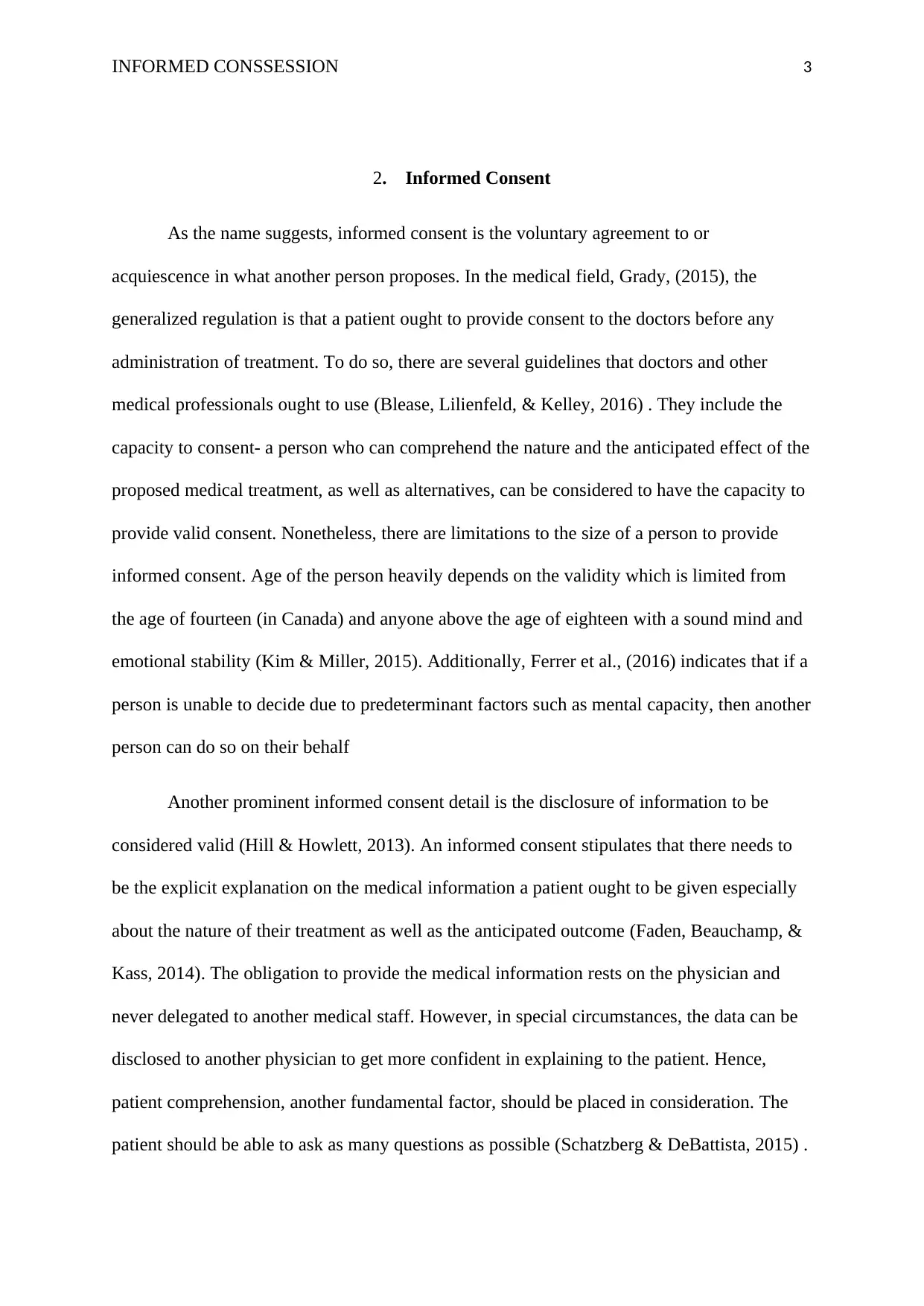
INFORMED CONSSESSION 3
2. Informed Consent
As the name suggests, informed consent is the voluntary agreement to or
acquiescence in what another person proposes. In the medical field, Grady, (2015), the
generalized regulation is that a patient ought to provide consent to the doctors before any
administration of treatment. To do so, there are several guidelines that doctors and other
medical professionals ought to use (Blease, Lilienfeld, & Kelley, 2016) . They include the
capacity to consent- a person who can comprehend the nature and the anticipated effect of the
proposed medical treatment, as well as alternatives, can be considered to have the capacity to
provide valid consent. Nonetheless, there are limitations to the size of a person to provide
informed consent. Age of the person heavily depends on the validity which is limited from
the age of fourteen (in Canada) and anyone above the age of eighteen with a sound mind and
emotional stability (Kim & Miller, 2015). Additionally, Ferrer et al., (2016) indicates that if a
person is unable to decide due to predeterminant factors such as mental capacity, then another
person can do so on their behalf
Another prominent informed consent detail is the disclosure of information to be
considered valid (Hill & Howlett, 2013). An informed consent stipulates that there needs to
be the explicit explanation on the medical information a patient ought to be given especially
about the nature of their treatment as well as the anticipated outcome (Faden, Beauchamp, &
Kass, 2014). The obligation to provide the medical information rests on the physician and
never delegated to another medical staff. However, in special circumstances, the data can be
disclosed to another physician to get more confident in explaining to the patient. Hence,
patient comprehension, another fundamental factor, should be placed in consideration. The
patient should be able to ask as many questions as possible (Schatzberg & DeBattista, 2015) .
2. Informed Consent
As the name suggests, informed consent is the voluntary agreement to or
acquiescence in what another person proposes. In the medical field, Grady, (2015), the
generalized regulation is that a patient ought to provide consent to the doctors before any
administration of treatment. To do so, there are several guidelines that doctors and other
medical professionals ought to use (Blease, Lilienfeld, & Kelley, 2016) . They include the
capacity to consent- a person who can comprehend the nature and the anticipated effect of the
proposed medical treatment, as well as alternatives, can be considered to have the capacity to
provide valid consent. Nonetheless, there are limitations to the size of a person to provide
informed consent. Age of the person heavily depends on the validity which is limited from
the age of fourteen (in Canada) and anyone above the age of eighteen with a sound mind and
emotional stability (Kim & Miller, 2015). Additionally, Ferrer et al., (2016) indicates that if a
person is unable to decide due to predeterminant factors such as mental capacity, then another
person can do so on their behalf
Another prominent informed consent detail is the disclosure of information to be
considered valid (Hill & Howlett, 2013). An informed consent stipulates that there needs to
be the explicit explanation on the medical information a patient ought to be given especially
about the nature of their treatment as well as the anticipated outcome (Faden, Beauchamp, &
Kass, 2014). The obligation to provide the medical information rests on the physician and
never delegated to another medical staff. However, in special circumstances, the data can be
disclosed to another physician to get more confident in explaining to the patient. Hence,
patient comprehension, another fundamental factor, should be placed in consideration. The
patient should be able to ask as many questions as possible (Schatzberg & DeBattista, 2015) .
⊘ This is a preview!⊘
Do you want full access?
Subscribe today to unlock all pages.

Trusted by 1+ million students worldwide
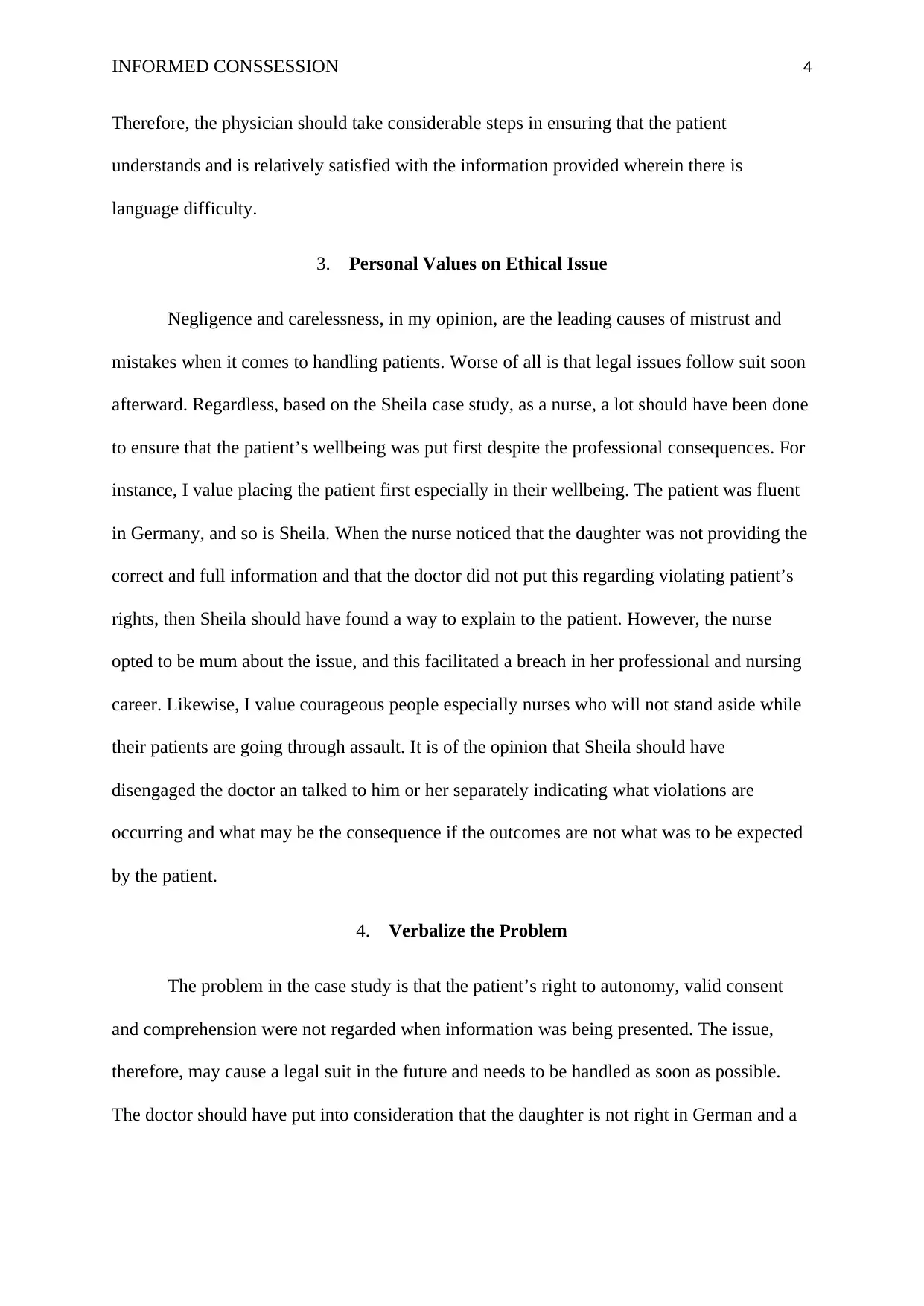
INFORMED CONSSESSION 4
Therefore, the physician should take considerable steps in ensuring that the patient
understands and is relatively satisfied with the information provided wherein there is
language difficulty.
3. Personal Values on Ethical Issue
Negligence and carelessness, in my opinion, are the leading causes of mistrust and
mistakes when it comes to handling patients. Worse of all is that legal issues follow suit soon
afterward. Regardless, based on the Sheila case study, as a nurse, a lot should have been done
to ensure that the patient’s wellbeing was put first despite the professional consequences. For
instance, I value placing the patient first especially in their wellbeing. The patient was fluent
in Germany, and so is Sheila. When the nurse noticed that the daughter was not providing the
correct and full information and that the doctor did not put this regarding violating patient’s
rights, then Sheila should have found a way to explain to the patient. However, the nurse
opted to be mum about the issue, and this facilitated a breach in her professional and nursing
career. Likewise, I value courageous people especially nurses who will not stand aside while
their patients are going through assault. It is of the opinion that Sheila should have
disengaged the doctor an talked to him or her separately indicating what violations are
occurring and what may be the consequence if the outcomes are not what was to be expected
by the patient.
4. Verbalize the Problem
The problem in the case study is that the patient’s right to autonomy, valid consent
and comprehension were not regarded when information was being presented. The issue,
therefore, may cause a legal suit in the future and needs to be handled as soon as possible.
The doctor should have put into consideration that the daughter is not right in German and a
Therefore, the physician should take considerable steps in ensuring that the patient
understands and is relatively satisfied with the information provided wherein there is
language difficulty.
3. Personal Values on Ethical Issue
Negligence and carelessness, in my opinion, are the leading causes of mistrust and
mistakes when it comes to handling patients. Worse of all is that legal issues follow suit soon
afterward. Regardless, based on the Sheila case study, as a nurse, a lot should have been done
to ensure that the patient’s wellbeing was put first despite the professional consequences. For
instance, I value placing the patient first especially in their wellbeing. The patient was fluent
in Germany, and so is Sheila. When the nurse noticed that the daughter was not providing the
correct and full information and that the doctor did not put this regarding violating patient’s
rights, then Sheila should have found a way to explain to the patient. However, the nurse
opted to be mum about the issue, and this facilitated a breach in her professional and nursing
career. Likewise, I value courageous people especially nurses who will not stand aside while
their patients are going through assault. It is of the opinion that Sheila should have
disengaged the doctor an talked to him or her separately indicating what violations are
occurring and what may be the consequence if the outcomes are not what was to be expected
by the patient.
4. Verbalize the Problem
The problem in the case study is that the patient’s right to autonomy, valid consent
and comprehension were not regarded when information was being presented. The issue,
therefore, may cause a legal suit in the future and needs to be handled as soon as possible.
The doctor should have put into consideration that the daughter is not right in German and a
Paraphrase This Document
Need a fresh take? Get an instant paraphrase of this document with our AI Paraphraser
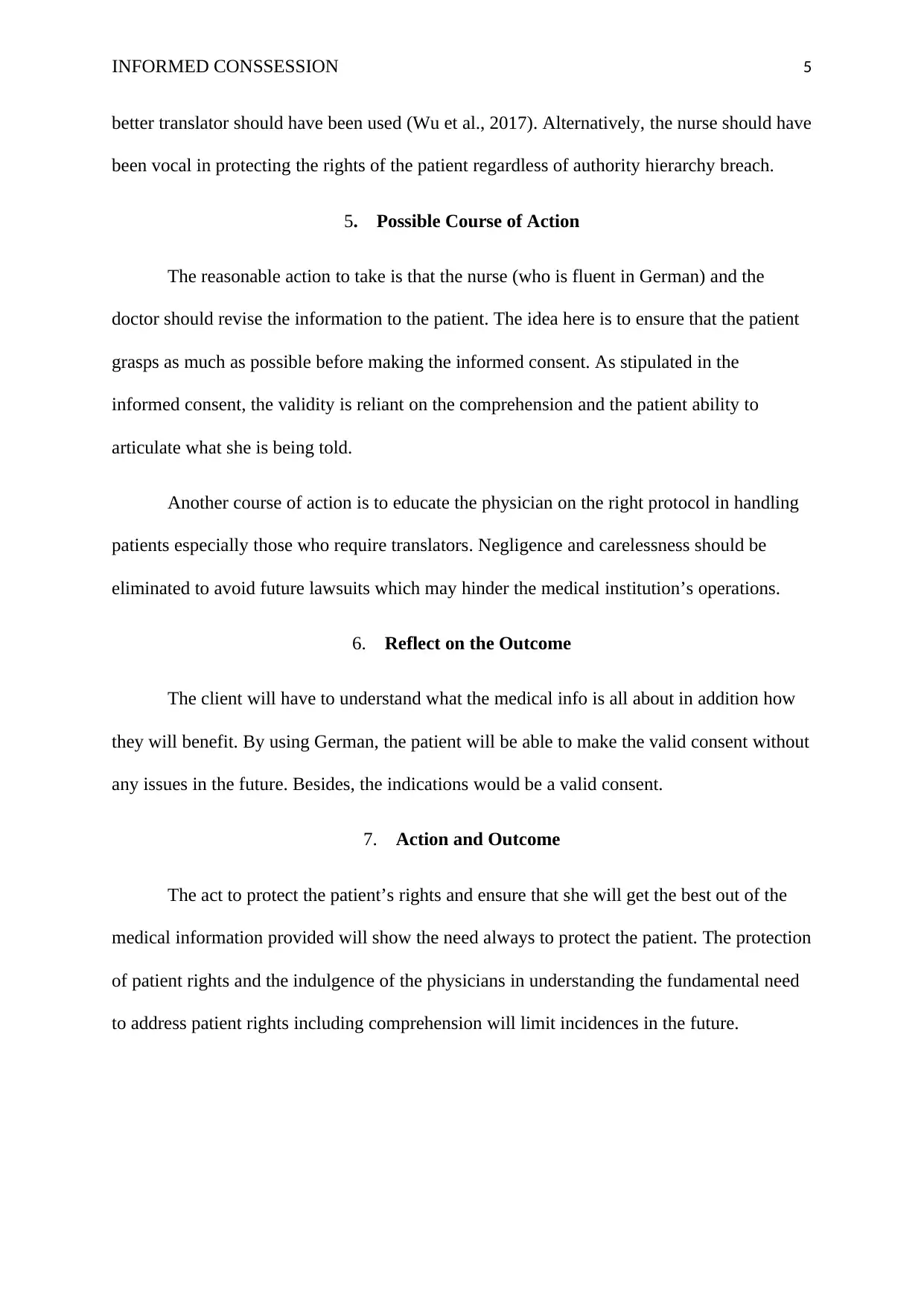
INFORMED CONSSESSION 5
better translator should have been used (Wu et al., 2017). Alternatively, the nurse should have
been vocal in protecting the rights of the patient regardless of authority hierarchy breach.
5. Possible Course of Action
The reasonable action to take is that the nurse (who is fluent in German) and the
doctor should revise the information to the patient. The idea here is to ensure that the patient
grasps as much as possible before making the informed consent. As stipulated in the
informed consent, the validity is reliant on the comprehension and the patient ability to
articulate what she is being told.
Another course of action is to educate the physician on the right protocol in handling
patients especially those who require translators. Negligence and carelessness should be
eliminated to avoid future lawsuits which may hinder the medical institution’s operations.
6. Reflect on the Outcome
The client will have to understand what the medical info is all about in addition how
they will benefit. By using German, the patient will be able to make the valid consent without
any issues in the future. Besides, the indications would be a valid consent.
7. Action and Outcome
The act to protect the patient’s rights and ensure that she will get the best out of the
medical information provided will show the need always to protect the patient. The protection
of patient rights and the indulgence of the physicians in understanding the fundamental need
to address patient rights including comprehension will limit incidences in the future.
better translator should have been used (Wu et al., 2017). Alternatively, the nurse should have
been vocal in protecting the rights of the patient regardless of authority hierarchy breach.
5. Possible Course of Action
The reasonable action to take is that the nurse (who is fluent in German) and the
doctor should revise the information to the patient. The idea here is to ensure that the patient
grasps as much as possible before making the informed consent. As stipulated in the
informed consent, the validity is reliant on the comprehension and the patient ability to
articulate what she is being told.
Another course of action is to educate the physician on the right protocol in handling
patients especially those who require translators. Negligence and carelessness should be
eliminated to avoid future lawsuits which may hinder the medical institution’s operations.
6. Reflect on the Outcome
The client will have to understand what the medical info is all about in addition how
they will benefit. By using German, the patient will be able to make the valid consent without
any issues in the future. Besides, the indications would be a valid consent.
7. Action and Outcome
The act to protect the patient’s rights and ensure that she will get the best out of the
medical information provided will show the need always to protect the patient. The protection
of patient rights and the indulgence of the physicians in understanding the fundamental need
to address patient rights including comprehension will limit incidences in the future.

INFORMED CONSSESSION 6
Professional Standards
According to CLPNBC, ever registered nursing profession including a Licensed
Profession Nurse under the Health Professions Act is required to serve and protect the public
as well as exercise the powers in addition to discharging responsibilities under all the
enactments in the public interests (“Nurses (Licensed Practical) Regulation,” ). For an LPN
under the BC curriculum, measurements include the practical application of nursing in the
assigned environment. Nonetheless, some duties and responsibilities are used to measure an
LPN that include making a diagnosis, compounding and administering medicine to patients.
Also, an LPN is regulated under the BC through the restricted duties that involve performing
procedures on tissue damages, cannot deliver medication that is complex and cannot handle
complicated equipment without a supervisor’s presence. Nevertheless, there are professional
standards that an LPN ought to carry out and will be stated below:
Responsibility and Accountability
According to the values, nurses (LPN) are required to uphold the professional
responsibilities in professional integrity and advocate for the rights of the patient which
Sheila should have adhered to during the provision of information. About CLPNBC, LPN
practice in BC mandates that nurses according to the Health Professions Act Section 16 (1),
nurses are required to exercise powers and discharge responsibilities (“Nurses (Licensed
Practical) Regulation,” n.d.). Sheila, the nurse, should have carried out her sole duty in
protecting the patient’s wellbeing regardless of what the physician had instructed her to do.
Moreover, the responsibility and accountability require that a nurse as well as a medical
profession, irrespective of the circumstance, be respectful of the patient’s rights and serve the
patient with the utmost professionalism (Spatz, Krumholz, & Moulton, 2016).
Competency-Based Practice
Professional Standards
According to CLPNBC, ever registered nursing profession including a Licensed
Profession Nurse under the Health Professions Act is required to serve and protect the public
as well as exercise the powers in addition to discharging responsibilities under all the
enactments in the public interests (“Nurses (Licensed Practical) Regulation,” ). For an LPN
under the BC curriculum, measurements include the practical application of nursing in the
assigned environment. Nonetheless, some duties and responsibilities are used to measure an
LPN that include making a diagnosis, compounding and administering medicine to patients.
Also, an LPN is regulated under the BC through the restricted duties that involve performing
procedures on tissue damages, cannot deliver medication that is complex and cannot handle
complicated equipment without a supervisor’s presence. Nevertheless, there are professional
standards that an LPN ought to carry out and will be stated below:
Responsibility and Accountability
According to the values, nurses (LPN) are required to uphold the professional
responsibilities in professional integrity and advocate for the rights of the patient which
Sheila should have adhered to during the provision of information. About CLPNBC, LPN
practice in BC mandates that nurses according to the Health Professions Act Section 16 (1),
nurses are required to exercise powers and discharge responsibilities (“Nurses (Licensed
Practical) Regulation,” n.d.). Sheila, the nurse, should have carried out her sole duty in
protecting the patient’s wellbeing regardless of what the physician had instructed her to do.
Moreover, the responsibility and accountability require that a nurse as well as a medical
profession, irrespective of the circumstance, be respectful of the patient’s rights and serve the
patient with the utmost professionalism (Spatz, Krumholz, & Moulton, 2016).
Competency-Based Practice
⊘ This is a preview!⊘
Do you want full access?
Subscribe today to unlock all pages.

Trusted by 1+ million students worldwide
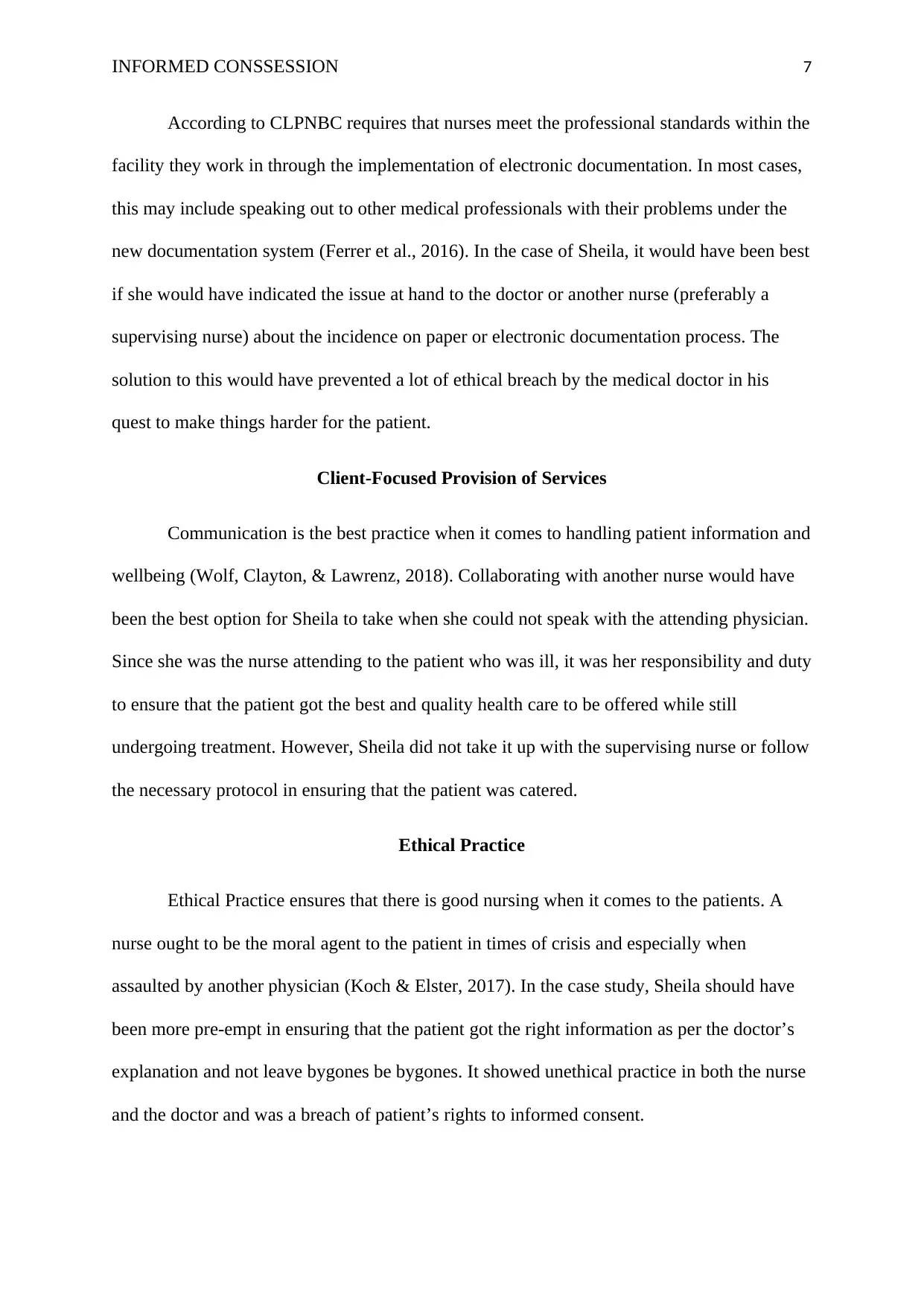
INFORMED CONSSESSION 7
According to CLPNBC requires that nurses meet the professional standards within the
facility they work in through the implementation of electronic documentation. In most cases,
this may include speaking out to other medical professionals with their problems under the
new documentation system (Ferrer et al., 2016). In the case of Sheila, it would have been best
if she would have indicated the issue at hand to the doctor or another nurse (preferably a
supervising nurse) about the incidence on paper or electronic documentation process. The
solution to this would have prevented a lot of ethical breach by the medical doctor in his
quest to make things harder for the patient.
Client-Focused Provision of Services
Communication is the best practice when it comes to handling patient information and
wellbeing (Wolf, Clayton, & Lawrenz, 2018). Collaborating with another nurse would have
been the best option for Sheila to take when she could not speak with the attending physician.
Since she was the nurse attending to the patient who was ill, it was her responsibility and duty
to ensure that the patient got the best and quality health care to be offered while still
undergoing treatment. However, Sheila did not take it up with the supervising nurse or follow
the necessary protocol in ensuring that the patient was catered.
Ethical Practice
Ethical Practice ensures that there is good nursing when it comes to the patients. A
nurse ought to be the moral agent to the patient in times of crisis and especially when
assaulted by another physician (Koch & Elster, 2017). In the case study, Sheila should have
been more pre-empt in ensuring that the patient got the right information as per the doctor’s
explanation and not leave bygones be bygones. It showed unethical practice in both the nurse
and the doctor and was a breach of patient’s rights to informed consent.
According to CLPNBC requires that nurses meet the professional standards within the
facility they work in through the implementation of electronic documentation. In most cases,
this may include speaking out to other medical professionals with their problems under the
new documentation system (Ferrer et al., 2016). In the case of Sheila, it would have been best
if she would have indicated the issue at hand to the doctor or another nurse (preferably a
supervising nurse) about the incidence on paper or electronic documentation process. The
solution to this would have prevented a lot of ethical breach by the medical doctor in his
quest to make things harder for the patient.
Client-Focused Provision of Services
Communication is the best practice when it comes to handling patient information and
wellbeing (Wolf, Clayton, & Lawrenz, 2018). Collaborating with another nurse would have
been the best option for Sheila to take when she could not speak with the attending physician.
Since she was the nurse attending to the patient who was ill, it was her responsibility and duty
to ensure that the patient got the best and quality health care to be offered while still
undergoing treatment. However, Sheila did not take it up with the supervising nurse or follow
the necessary protocol in ensuring that the patient was catered.
Ethical Practice
Ethical Practice ensures that there is good nursing when it comes to the patients. A
nurse ought to be the moral agent to the patient in times of crisis and especially when
assaulted by another physician (Koch & Elster, 2017). In the case study, Sheila should have
been more pre-empt in ensuring that the patient got the right information as per the doctor’s
explanation and not leave bygones be bygones. It showed unethical practice in both the nurse
and the doctor and was a breach of patient’s rights to informed consent.
Paraphrase This Document
Need a fresh take? Get an instant paraphrase of this document with our AI Paraphraser
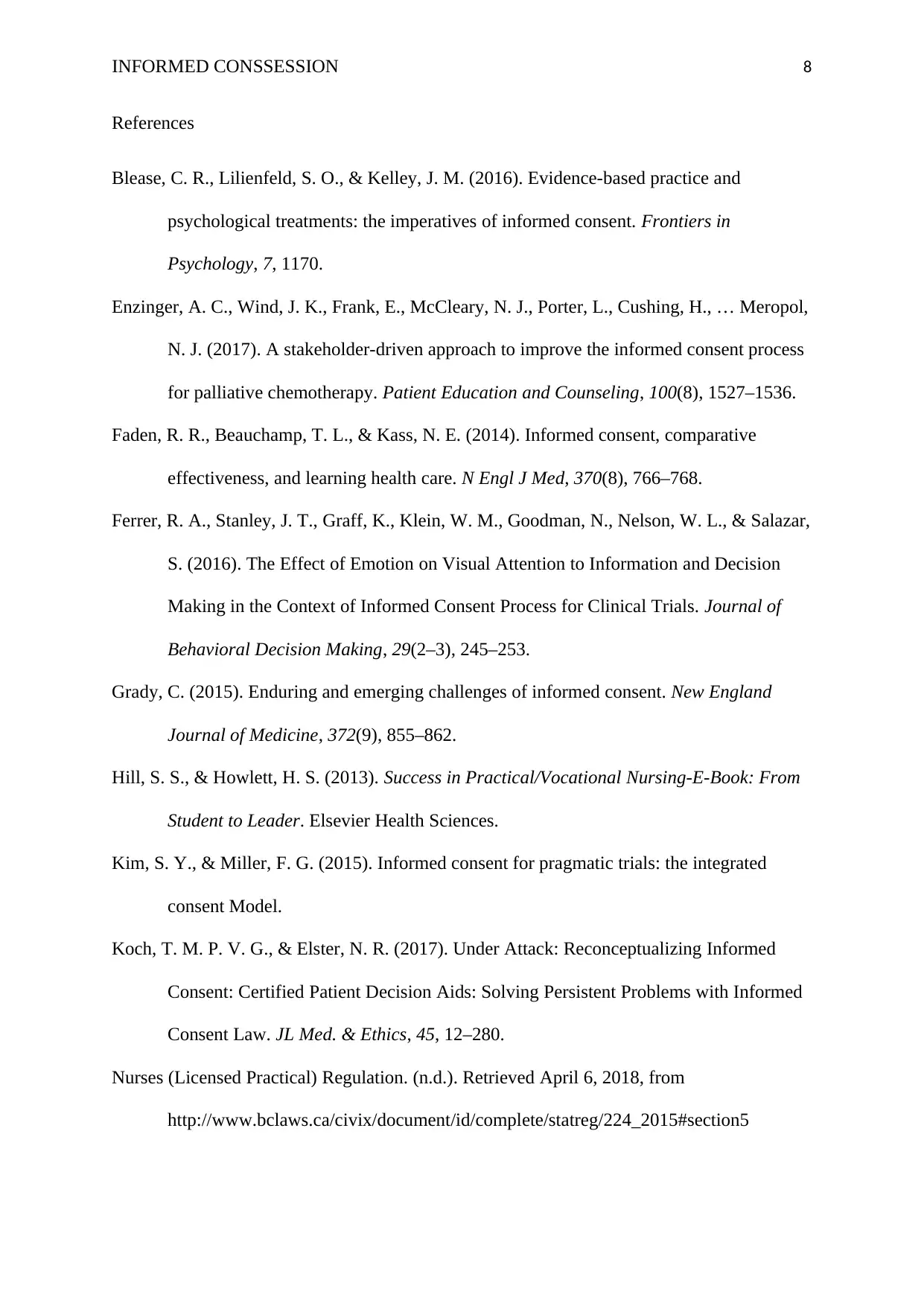
INFORMED CONSSESSION 8
References
Blease, C. R., Lilienfeld, S. O., & Kelley, J. M. (2016). Evidence-based practice and
psychological treatments: the imperatives of informed consent. Frontiers in
Psychology, 7, 1170.
Enzinger, A. C., Wind, J. K., Frank, E., McCleary, N. J., Porter, L., Cushing, H., … Meropol,
N. J. (2017). A stakeholder-driven approach to improve the informed consent process
for palliative chemotherapy. Patient Education and Counseling, 100(8), 1527–1536.
Faden, R. R., Beauchamp, T. L., & Kass, N. E. (2014). Informed consent, comparative
effectiveness, and learning health care. N Engl J Med, 370(8), 766–768.
Ferrer, R. A., Stanley, J. T., Graff, K., Klein, W. M., Goodman, N., Nelson, W. L., & Salazar,
S. (2016). The Effect of Emotion on Visual Attention to Information and Decision
Making in the Context of Informed Consent Process for Clinical Trials. Journal of
Behavioral Decision Making, 29(2–3), 245–253.
Grady, C. (2015). Enduring and emerging challenges of informed consent. New England
Journal of Medicine, 372(9), 855–862.
Hill, S. S., & Howlett, H. S. (2013). Success in Practical/Vocational Nursing-E-Book: From
Student to Leader. Elsevier Health Sciences.
Kim, S. Y., & Miller, F. G. (2015). Informed consent for pragmatic trials: the integrated
consent Model.
Koch, T. M. P. V. G., & Elster, N. R. (2017). Under Attack: Reconceptualizing Informed
Consent: Certified Patient Decision Aids: Solving Persistent Problems with Informed
Consent Law. JL Med. & Ethics, 45, 12–280.
Nurses (Licensed Practical) Regulation. (n.d.). Retrieved April 6, 2018, from
http://www.bclaws.ca/civix/document/id/complete/statreg/224_2015#section5
References
Blease, C. R., Lilienfeld, S. O., & Kelley, J. M. (2016). Evidence-based practice and
psychological treatments: the imperatives of informed consent. Frontiers in
Psychology, 7, 1170.
Enzinger, A. C., Wind, J. K., Frank, E., McCleary, N. J., Porter, L., Cushing, H., … Meropol,
N. J. (2017). A stakeholder-driven approach to improve the informed consent process
for palliative chemotherapy. Patient Education and Counseling, 100(8), 1527–1536.
Faden, R. R., Beauchamp, T. L., & Kass, N. E. (2014). Informed consent, comparative
effectiveness, and learning health care. N Engl J Med, 370(8), 766–768.
Ferrer, R. A., Stanley, J. T., Graff, K., Klein, W. M., Goodman, N., Nelson, W. L., & Salazar,
S. (2016). The Effect of Emotion on Visual Attention to Information and Decision
Making in the Context of Informed Consent Process for Clinical Trials. Journal of
Behavioral Decision Making, 29(2–3), 245–253.
Grady, C. (2015). Enduring and emerging challenges of informed consent. New England
Journal of Medicine, 372(9), 855–862.
Hill, S. S., & Howlett, H. S. (2013). Success in Practical/Vocational Nursing-E-Book: From
Student to Leader. Elsevier Health Sciences.
Kim, S. Y., & Miller, F. G. (2015). Informed consent for pragmatic trials: the integrated
consent Model.
Koch, T. M. P. V. G., & Elster, N. R. (2017). Under Attack: Reconceptualizing Informed
Consent: Certified Patient Decision Aids: Solving Persistent Problems with Informed
Consent Law. JL Med. & Ethics, 45, 12–280.
Nurses (Licensed Practical) Regulation. (n.d.). Retrieved April 6, 2018, from
http://www.bclaws.ca/civix/document/id/complete/statreg/224_2015#section5

INFORMED CONSSESSION 9
Potter, P. A., Perry, A. G., Stockert, P. A., & Hall, A. M. (2014). Canadian fundamentals of
nursing (5th Cdn. ed.)(JC Ross-Kerr, MJ Wood, BJ Astle & W. Duggleby, Cdn.
Adapt.). Toronto, ON: Elsevier Canada.
Schatzberg, A. F., & DeBattista, C. (2015). Manual of clinical psychopharmacology.
American Psychiatric Pub.
Spatz, E. S., Krumholz, H. M., & Moulton, B. W. (2016). The new era of informed consent:
getting to a reasonable-patient standard through shared decision making. Jama,
315(19), 2063–2064.
Wolf, S. M., Clayton, E. W., & Lawrenz, F. (2018). The Past, Present, and Future of
Informed Consent in Research and Translational Medicine. SAGE Publications Sage
CA: Los Angeles, CA.
Wu, Y., Howarth, M. L., Chunlan, Z., Xue, J., Jiexia, O., & Xiaojin, L. (2017). Reporting of
ethical approval and informed consent in clinical trials in 12 nursing journals in China
between 2013 and 2016. Nursing Ethics, 1–11.
Potter, P. A., Perry, A. G., Stockert, P. A., & Hall, A. M. (2014). Canadian fundamentals of
nursing (5th Cdn. ed.)(JC Ross-Kerr, MJ Wood, BJ Astle & W. Duggleby, Cdn.
Adapt.). Toronto, ON: Elsevier Canada.
Schatzberg, A. F., & DeBattista, C. (2015). Manual of clinical psychopharmacology.
American Psychiatric Pub.
Spatz, E. S., Krumholz, H. M., & Moulton, B. W. (2016). The new era of informed consent:
getting to a reasonable-patient standard through shared decision making. Jama,
315(19), 2063–2064.
Wolf, S. M., Clayton, E. W., & Lawrenz, F. (2018). The Past, Present, and Future of
Informed Consent in Research and Translational Medicine. SAGE Publications Sage
CA: Los Angeles, CA.
Wu, Y., Howarth, M. L., Chunlan, Z., Xue, J., Jiexia, O., & Xiaojin, L. (2017). Reporting of
ethical approval and informed consent in clinical trials in 12 nursing journals in China
between 2013 and 2016. Nursing Ethics, 1–11.
⊘ This is a preview!⊘
Do you want full access?
Subscribe today to unlock all pages.

Trusted by 1+ million students worldwide
1 out of 9
Related Documents
Your All-in-One AI-Powered Toolkit for Academic Success.
+13062052269
info@desklib.com
Available 24*7 on WhatsApp / Email
![[object Object]](/_next/static/media/star-bottom.7253800d.svg)
Unlock your academic potential
Copyright © 2020–2025 A2Z Services. All Rights Reserved. Developed and managed by ZUCOL.





